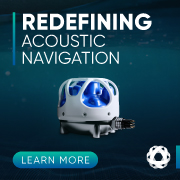
Saildrone Launches First Freshwater Mission in the Great Lakes
09.08.2021
Saildrone’s fleet of uncrewed surface vehicles (USVs) has proven its data collection capabilities over seven years of operation from the Arctic to the Antarctic. Now, these ocean drones have entered a new maritime domain—the Great Lakes. Two Saildrone Explorers were deployed from Macatawa, MI, for a 45-day fisheries mission on behalf of the US Geological Survey (USGS)’s Great Lakes Science Center (GSLC).
SD 1032 and SD 1046 at the dock in Macatawa, MI, before being deployed to Lake Michigan for the 2021 Great Lakes Fisheries mission.
While Saildrone has operated missions for scientific data collection, mapping, and maritime domain awareness in every ocean on the planet, this is the first Saildrone mission on any freshwater body.
North America’s Great Lakes make up the world’s largest freshwater ecosystem. The Great Lakes support a $7 billion commercial and recreational fishing industry, but human-caused and natural changes like degraded habitat, climate, and invasive mussels threaten the health of popular fisheries like lake trout, whitefish, walleye, and northern pike.

The two Saildrone Explorers were deployed from Macatawa on the west coast of Michigan and will sail north through Lake Michigan, under the Mackinac Bridge, and into Lake Huron during the 45-day fisheries mission. (This map is for illustrative purposes only and is not the actual mission track.)
The standard Saildrone sensor suite includes science-grade instruments to collect air, sea, and skin temperature, wind speed and direction, relative humidity, barometric pressure, photosynthetically active radiation, salinity, dissolved oxygen, chlorophyll, and wave height and period. Saildrones can also measure ocean current speed and direction and air-sea carbon exchange. While the saildrones collect fisheries data on the Great Lakes, they will simultaneously be collecting meteorological data, which will be used by the National Weather Service to inform weather forecasting.
The vehicles were deployed on July 28, and the mission officially begun, August 5.
Saildrones are not single-mission vehicles; they are designed for multiple deployments over their long lifespan. SD 1046, one of the two saildrones operating in the Great Lakes this summer, was previously deployed from Saildrone headquarters in Alameda, CA, on the San Francisco Bay to sail across the North Pacific Ocean to the Bering Sea where it performed the 2020 Alaska pollock survey on behalf of the National Oceanic and Atmospheric Administration (NOAA)’s Alaska Fisheries Science Center (AFSC). In 2019, SD 1046 was one of seven saildrones to perform a 60-day fisheries mission along the US West Coast from Cape Flattery, WA, to San Diego, CA.
The second saildrone, SD 1032, was previously deployed to the North Sea for a fisheries mission on behalf of Norway’s Institute of Marine Research.
This summer, the Saildrone fleet is simultaneously operating missions in the Pacific Ocean, Bering Sea, and Atlantic Ocean collecting valuable ocean data for climate science, fisheries, and ocean mapping. The 72-foot Surveyor completed its first ocean mapping mission from San Francisco to Hawaii in early July, and a group of Saildrone Explorers equipped with special “hurricane wings” was deployed from Jacksonville, FL, and the US Virgin Islands mid-month to collect data from inside Atlantic hurricanes.

Location: Great Lakes, USA











